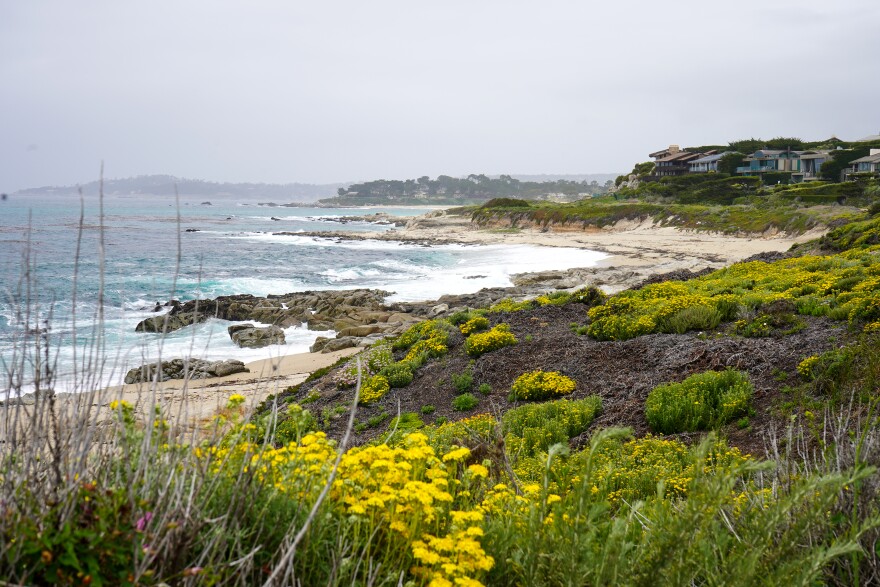The winter storms that brought so much damage to California earlier this year left behind a “superbloom” of wildflowers. The flowers that are blanketing the state are so vibrant, they can be seen from space by satellite.
Of course, the best way to see them is at ground level.
Erin Hunter is a friend, and a local artist and science illustrator. She has taught science illustration at Stanford, and has an upcoming course this summer at CSU Monterey Bay. As an artist with a focus on science, she is the perfect guide to the spring rebirth of our region’s wildlands.

Hunter and I met for a walk down a short coastal trail in Monterey County. The trail starts near an old red schoolhouse that sits among a grove of eucalyptus trees, just north of Monastery Beach.
As we walked, we talked about what we saw and the impact this year’s bloom is having on the environment.
This interview has been edited for length and clarity.
Doug McKnight (DM) You picked this spot because you said there were a lot of flowers here.
Erin Hunter (EH): I went and looked at the interior at Fort Ord and some other places and they are really starting to dry out now. But here on the coast, right on the coast, right on the water, things are still really lush. And you get that sort of carpet effect where you have a lot of blooms coming in at the same time.

DM: Are the flowers here different from inland?
EH: I think what you find in all areas is that there are families that have certain plants that are inland and then certain plants that are on the coast. And each of them has various adaptations to make it so that they can live in the environment. So here along the coast, because it's quite windy, you have plants that are much more low growing and hugging the ground and then in more forested areas you might have plants that are taller that are reaching for the sunlight.
The gravel path beneath us is lined with yellow flowers, but Erin says not all plants along the coast are native to California, and the invasive species are crowding out the native plants.

EH: Part of the reason I wanted to walk through here, is that one of the effects of having a lot of rain this winter is that not only are the wildflowers really coming in, but all the invasive species and weeds are coming in really thickly as well. You've got a whole bunch of hemlock, those really tall plants there. Those are non-native. There's a whole bunch over here of this black mustard. That's non-native. They're quite lush and there's not a lot of room for other things to grow.
The path curves revealing the dark blue Pacific.
EH: The View is really lovely through here, opening out onto the open ocean. This right here is Artemisia. This is California sagebrush. This one is wind pollinated. So it doesn't really have a very big flower. And in fact,This one is not flowering right now.
DM: It looks more like a conifer tree.
EH: Yeah, it's got these really divided leaves, so they're quite fine. And it's really fragrant, too. If you can pinch the leaves and smell it, it's got a really distinctive scent to it.
Erin spots one of her favorite wildflowers.

EH: I love this one. This is a seaside painted cup. Some of the paintbrush that people often see are scarlet in color. These are more of a — I don't know, almost like a persimmon orange. And they're much more rounded. You see a range of colors. These are peach colored here and those over there are more orange. So there's a lot of variation in these plants.
DM: They have a very small bud.
EH: Yeah. And there is lots of poison oak here as well.

This is an ice plant, also called Hottentot fig. It's non-native and grows all over the slopes. You see it quite a lot as you're driving along Highway 1. I know people use it for stabilizing slopes, but it can be pretty invasive and it can really take over.
DM: Where is it native to?
EH: South Africa. It has a Mediterranean climate like we do. We have a lot of landscaping plants that are from South Africa and some of them go on to become invasive. Calla lilies are a good example of something that was grown as a cultivated plant and is now in drainages and washes. You'll see it down the coast in the little canyons on your way to Big Sur. It can establish itself and become really quite widespread and crowd out native species.

As we head back to our cars, Erin points out that the wildflowers are not only beautiful, they’re home to all kinds of creatures. Birds and bees and bugs. Pollinators that assure there is a bloom next year. And all you have to do to see them is slow down and look.
EH: I was an artist in residence at Guadalupe Mountains National Park in West Texas. It's a really forbidding landscape, and we met these three young guys who were hiking really fast. My younger daughter was in the backpack and my older daughter was four at the time. We said, “Oh, we're looking for bugs, we're looking for flowers and things.” And they said, “Well, we haven't seen anything.” And I thought, well, you should hike with a four year old. They move at the right speed. They're the right height. They notice everything.
The superbloom continues along the coastal trails and in some of the wetter areas of the state. If you decide to take a look, don’t forget to take some kids — they just might help you discover something you overlooked.



